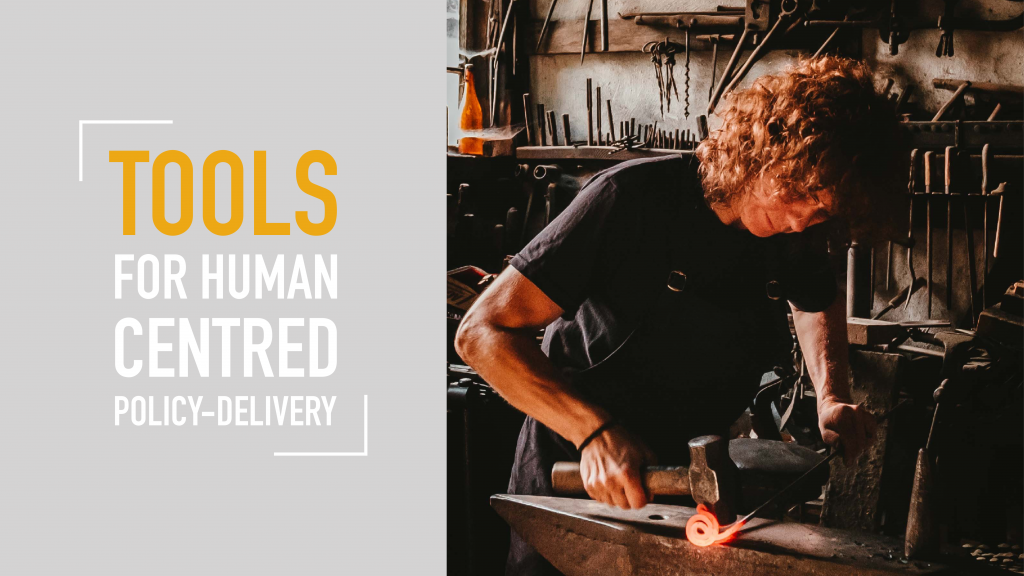In our last blog we outlined a framework we developed for human-centered policy-delivery. By going through a series of seven iterative steps from problem definition over ideation to implementation, policy-makers can design solutions that fit the needs of the citizens.
In this blog we will introduce you to three methods that can be applied in the first three steps of the human-centred policy-delivery process we developed. Also, we will introduce you to real-life examples in which these selected tools were already applied in the public sector.
Creating an open mindset
Applying a human-centered approach can be different to the usual mode of work in public sector organizations: few hierarchies, and an open ended and iterative process. Therefore, before applying methods outlined below yourself, we encourage you to get into a state-of-mind which
- Embraces new perspectives: A general open attitude to try out new things that might be outside of one’s comfort zone is important. That way one can look over the horizon that previously limited the impact of policies.
- Embraces co-creation: Being part of a team, in which ideas can freely be developed and one feels safe to share and learn is very important. Limiting the influence of hierarchy and regularly checking-in with the members can be beneficial.
- Embraces the design process: Especially when things become more difficult, remembering that failing is part of the process and intended. If everything goes as planned you might want to try for something more outside of the box.
Understand and define
The first set of tools focuses on the first two steps of the human-centred policy-delivery process. The goal here is to understand the needs of the citizens and define the problem that you want to solve – not thinkinking about possible solutions, yet.
User interviews:
- What is it: Talking and listening to citizens or users can help to better understand how they experience a situation. This can be done in an informal setting when the opportunity occurs or in a more systematic way (e.g. surveys). It is important to really try to hear what they have to say. We encourage you to try to find insights that challenge your current understanding of the problem, by asking open-ended questions (e.g. why, how, in what way?) and avoiding leading ones.
- Real-life example: The Danish MindLab interviewed medical professionals as well as patients during the process of redesigning public hospitals. They were able to dive deep in their world and incorporated these different perspectives and needs into their solutions. They realised for example, that the problem with the food served in hospitals was rather the presentation and less the taste. By improving on it, patients would eat more and recover quicker. These and other changes resulted in a more sustainable patient journey that focuses on long-term health.
- Dive deeper: Here are some tips for getting the most out of your interviews.
(Participatory) Observation:
- What is it: This technique helps to put oneself into the situation of the user and to really understand the problem s/he is facing in a specific situation. For example, noticing how they behave, what problems they encounter and with whom they interact can generate insight to define their needs and in what ecosystem the solution has to fit. If possible, participation in the activities is a great way to learn more and raise questions about the status quo. That way needs can be discovered, that might not have been realised by the stakeholders themselves.
- Real-life example: The Canadian Revenue Agency observed people experiencing homelessness, agency employees as well as volunteers during the tax filing process. They identified key points in the design and layout of the process that, after implementing changes, ensured that all Canadians are able to receive the benefits they are entitled to. They combined tax services with other offers such as health and housing information, and employment training, so filing the taxes requires a smaller effort from the citizens.
- Dive deeper: Here are some tips of how to start and document your observation.
Personas:
- What is it: Creating a fictional person that incorporates characteristics of the potential user found for example in the interviews can help define the problem. They should incorporate basic information like age, education and job. Answering questions like what does this person like and dislike, what are their dreams and fears etc. makes them more complex and realistic. Creating different personas for different groups of potential users can show needs that are overlapping. It is important that personas are always based in reality and the insights gathered from research.
- Real-life example: The American Digital.Gov Team involved key stakeholders and different sources of data to build personas, that each have different needs when it comes to using digital services by the government. They identified four different needs: completing a transaction, finding specific information on a known topic, browsing information or learning more on a general topic, finding contact information for an agency or elected official. New digital services were designed to address all four of these needs.
- Dive deeper: Here are some more tips for creating personas.
Do you have experiences working with any of the tools mentioned above or do you have other methods that you found helpful? We would love to learn from your experiences – get in touch or leave a comment in the section below!
The next blog will focus on tools that can be applied in designing, implementing and evaluating a new policy, all through a human-centered perspective.
